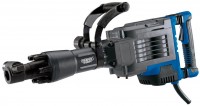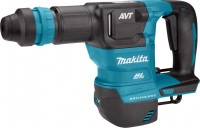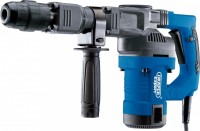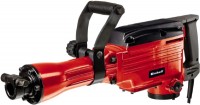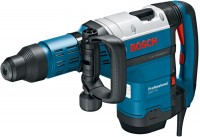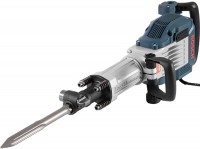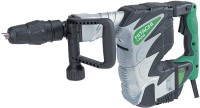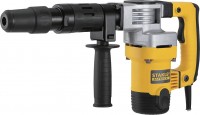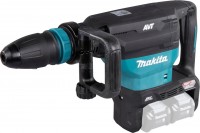Demolition Hammers Makita
All models Advanced filters → |
You might be interested in
Articles, reviews, useful tips
All materials
What is the best screwdriver?
Among thousands of screwdrivers, you can find one that surpasses the rest in all respects. Or is it impossible?

One battery for the whole tool: multi-platform battery series
The concept of using a universal battery for cordless tools is gaining momentum

Screwdriver that can drill concrete: myth or reality
What does it take to drill a hole in the wall with a screwdriver? Which model should I choose for drilling concrete?

Which is better: drill, screwdriver or drill-driver?
We study the design features and specifics of the use of such similar, but still different types of power tools
Demolition Hammers: specifications, types
Product type
The type of device is indicated for specialized tools that are not related to general purpose demolition hammers. Nowadays, there are three main varieties of such tools: scalers(needle hammers), pilers and scrapers. Here are their features:
— Needle hammer (scaler). Such models are relatively small in size and weight, they are traditionally made pneumatic, and the working equipment looks like a bunch of needles (hence the name). In the simplest scalers, the needles are rigidly connected and move simultaneously during operation, but this arrangement is only suitable for flat surfaces. Therefore, devices with floating, independent needles are more popular — they are more complicated and more expensive, but they can effectively cope with the processing of complex shapes. Anyway, the main purpose of scalers is to remove unnecessary coatings and formations from metal surfaces: rust, old paint, welding slag, etc. Due to the design features, such tools effectively cope with such work and at the same time do not damage the main surface; and when cleaning welding seams, processing with a scaler also helps to remove “metal fatigue” and can significantly increase reliability.
— Koper. In this case, "copra" is called specialized demolition hammers, designed for the possibility of driving piles, poles, pipes, etc. into the ground. They can also be used for more traditi...onal tasks, however, the main purpose is precisely the mentioned work, and it is almost necessary to supply includes a special nozzle for clogging (impact cup). Copra are traditionally made of gasoline, have significant weight and high impact energy — from 45 J, and in some models 60 J or more. Such characteristics make it possible to effectively hammer even rather thick pins and pipes with the help of one worker.
— Chabert. Specialized demolition hammers (usually pneumatic) for use with working attachments of the "scraper" type. Initially, such nozzles are actually used for scraping — high-precision alignment of various surfaces, most often metal; in addition, scrapers can scrape off rust, old paint and other similar coatings, as well as perform some other work. As for scraper hammers, they usually have a small mass and impact energy, but are capable of delivering a high frequency of blows, which contributes to productivity.
— Needle hammer (scaler). Such models are relatively small in size and weight, they are traditionally made pneumatic, and the working equipment looks like a bunch of needles (hence the name). In the simplest scalers, the needles are rigidly connected and move simultaneously during operation, but this arrangement is only suitable for flat surfaces. Therefore, devices with floating, independent needles are more popular — they are more complicated and more expensive, but they can effectively cope with the processing of complex shapes. Anyway, the main purpose of scalers is to remove unnecessary coatings and formations from metal surfaces: rust, old paint, welding slag, etc. Due to the design features, such tools effectively cope with such work and at the same time do not damage the main surface; and when cleaning welding seams, processing with a scaler also helps to remove “metal fatigue” and can significantly increase reliability.
— Koper. In this case, "copra" is called specialized demolition hammers, designed for the possibility of driving piles, poles, pipes, etc. into the ground. They can also be used for more traditi...onal tasks, however, the main purpose is precisely the mentioned work, and it is almost necessary to supply includes a special nozzle for clogging (impact cup). Copra are traditionally made of gasoline, have significant weight and high impact energy — from 45 J, and in some models 60 J or more. Such characteristics make it possible to effectively hammer even rather thick pins and pipes with the help of one worker.
— Chabert. Specialized demolition hammers (usually pneumatic) for use with working attachments of the "scraper" type. Initially, such nozzles are actually used for scraping — high-precision alignment of various surfaces, most often metal; in addition, scrapers can scrape off rust, old paint and other similar coatings, as well as perform some other work. As for scraper hammers, they usually have a small mass and impact energy, but are capable of delivering a high frequency of blows, which contributes to productivity.
Type
— Electric. Mains-powered models — usually, standard household 230 V. Such a tool is much easier to connect than a pneumatic one, it does not require additional equipment. On the other hand, electric demolition hammers of this type are poorly suited to work in conditions of high humidity (due to the sensitivity of electrical circuits to moisture), which, in particular, makes it difficult to use them in open areas — the ability to work with a tool directly depends on favorable weather conditions . Sparks often occur inside electrical units — and this, in turn, does not allow working in the presence of fumes of combustible substances, explosive dust, etc. However, situations in which these shortcomings play a decisive role are quite rare in fact; in addition, such a tool is constantly being improved, becoming more and more reliable and safe. There are also battery models, but about them separately.
— Pneumatic. Tools that use compressed air to work. These demolition hammers perform well in wet environments and generate virtually no sparks, making them suitable for use in environments where electric models would be unsuitable. The most obvious drawback of such a tool is the need to connect to a compressor. On the other hand, many modern compressors have petrol or diesel engines and can operate independently of the mains. Therefore, for large-scale outdoor work (in part...icular, road construction), it is the pneumatic tool that is considered the most suitable.
— Petrol. Units equipped with gasoline internal combustion engines. The main advantage of such tools is complete battery life — you can work with a gasoline demolition hammer regardless of the presence of external energy sources, there would be a supply of fuel in the tank. In addition, the power and performance can be quite impressive. On the other hand, gasoline units are complex in design and weigh more than their electric counterparts, not to mention pneumatic and hydraulic ones (although this point is not always a disadvantage, see "Weight" for more details), they are more expensive to operate, and the exhaust gases produced by the engine make it difficult to use indoors, and in the air they can create discomfort. Thus, relatively few demolition hammers of this type are produced, they belong to heavy professional models; and it makes sense to acquire such a tool if battery life outweighs all the disadvantages mentioned.
— Hydraulic. Demolition hammers powered by hydraulic pumping stations; in many ways similar to pneumatic ones (see above), they only use hydraulic fluid (oil) rather than air. One of the main advantages of this type, both in comparison with pneumatics and in general, is compactness: pumping stations are noticeably smaller than compressors, and the hammers themselves are smaller than electric and, especially, gasoline counterparts. This makes it easier to work in tight spaces. Also, the hydraulic drive is relatively quiet, not prone to sparking and insensitive to weather conditions. And pumping stations can be both gasoline and electric, which allows you to choose different connection methods for different situations. However such stations are not as widespread as pneumatic compressors, therefore relatively few hammers of this type are produced.
— Rechargeable. You should pay attention to battery models if the battery life of use is the main determining factor for you. Unlike network ones, they do not require an outlet and do not depend on the length of the power cord. At the same time, the power of such models is usually significantly lower, and the battery has a limited life. After that, it needs to be charged, sometimes for quite a long time. Note that battery-powered models have not yet received wide popularity.
— Pneumatic. Tools that use compressed air to work. These demolition hammers perform well in wet environments and generate virtually no sparks, making them suitable for use in environments where electric models would be unsuitable. The most obvious drawback of such a tool is the need to connect to a compressor. On the other hand, many modern compressors have petrol or diesel engines and can operate independently of the mains. Therefore, for large-scale outdoor work (in part...icular, road construction), it is the pneumatic tool that is considered the most suitable.
— Petrol. Units equipped with gasoline internal combustion engines. The main advantage of such tools is complete battery life — you can work with a gasoline demolition hammer regardless of the presence of external energy sources, there would be a supply of fuel in the tank. In addition, the power and performance can be quite impressive. On the other hand, gasoline units are complex in design and weigh more than their electric counterparts, not to mention pneumatic and hydraulic ones (although this point is not always a disadvantage, see "Weight" for more details), they are more expensive to operate, and the exhaust gases produced by the engine make it difficult to use indoors, and in the air they can create discomfort. Thus, relatively few demolition hammers of this type are produced, they belong to heavy professional models; and it makes sense to acquire such a tool if battery life outweighs all the disadvantages mentioned.
— Hydraulic. Demolition hammers powered by hydraulic pumping stations; in many ways similar to pneumatic ones (see above), they only use hydraulic fluid (oil) rather than air. One of the main advantages of this type, both in comparison with pneumatics and in general, is compactness: pumping stations are noticeably smaller than compressors, and the hammers themselves are smaller than electric and, especially, gasoline counterparts. This makes it easier to work in tight spaces. Also, the hydraulic drive is relatively quiet, not prone to sparking and insensitive to weather conditions. And pumping stations can be both gasoline and electric, which allows you to choose different connection methods for different situations. However such stations are not as widespread as pneumatic compressors, therefore relatively few hammers of this type are produced.
— Rechargeable. You should pay attention to battery models if the battery life of use is the main determining factor for you. Unlike network ones, they do not require an outlet and do not depend on the length of the power cord. At the same time, the power of such models is usually significantly lower, and the battery has a limited life. After that, it needs to be charged, sometimes for quite a long time. Note that battery-powered models have not yet received wide popularity.
Real power
Power delivered by a demolition hammer directly to a drill or other working equipment. This figure is inevitably lower than the power consumption (see below) due to energy losses in the tool mechanisms.
In general, higher net power means more efficiency and productivity; the reverse side of these advantages is an increase in price, energy consumption, dimensions and weight (however, the latter is not always a drawback for rotary hammers). In addition, note that tools with similar useful power values may differ in the ratio of chiseling speed and impact power: remember, a higher frequency means less energy for each individual impact, and vice versa. So the big numbers in this paragraph can mean both high efficiency when working with hard, stubborn materials, and good performance on relatively simple tasks; these features need to be specified separately.
Also, by the ratio of useful and consumed power, one can evaluate the efficiency of the tool in terms of energy consumption: the lower the power consumption (with the same useful power), the more efficient this model is. The downside of energy efficiency is often increased cost, but it can be recouped fairly quickly in energy savings, especially if you work long hours and often.
In general, higher net power means more efficiency and productivity; the reverse side of these advantages is an increase in price, energy consumption, dimensions and weight (however, the latter is not always a drawback for rotary hammers). In addition, note that tools with similar useful power values may differ in the ratio of chiseling speed and impact power: remember, a higher frequency means less energy for each individual impact, and vice versa. So the big numbers in this paragraph can mean both high efficiency when working with hard, stubborn materials, and good performance on relatively simple tasks; these features need to be specified separately.
Also, by the ratio of useful and consumed power, one can evaluate the efficiency of the tool in terms of energy consumption: the lower the power consumption (with the same useful power), the more efficient this model is. The downside of energy efficiency is often increased cost, but it can be recouped fairly quickly in energy savings, especially if you work long hours and often.
Power consumption
The power of the engine used in an electric or gasoline demolition hammer. This parameter is used to indicate the total power consumption (useful power is less due to losses in the mechanisms) and, accordingly, it determines the connection requirements: the power grid must be able to deliver the required current without overloads and failures.
In general, the more powerful the tool, the better it is able to handle hard materials or large volumes of work. High power values make it possible to provide adequate energy for each individual impact and/or numerous strokes per minute. At the same time, we can say that power is a secondary parameter, and when choosing, you should look primarily at more practically significant characteristics — the same impact energy or impact frequency.
In general, the more powerful the tool, the better it is able to handle hard materials or large volumes of work. High power values make it possible to provide adequate energy for each individual impact and/or numerous strokes per minute. At the same time, we can say that power is a secondary parameter, and when choosing, you should look primarily at more practically significant characteristics — the same impact energy or impact frequency.
Impact energy
The greatest kinetic energy that a demolition hammer is capable of delivering on each individual blow.
The higher the impact energy, the stronger each blow is and the easier it is for the demolition hammer to “bite” into complex hard materials. On the other hand, there is not always a real need for high values, despite the fact that this parameter significantly affects the total cost of the tool. Therefore, it is worth choosing a demolition hammer according to the impact energy, taking into account the specifics of the materials for which it is planned to be used. Detailed recommendations for specific cases can be found in special sources.
It is worth noting that since recently, many manufacturers (primarily well-known ones) have been testing impact energy according to the new EPTA standard, which on the same tool gives lower energy values than the old standards. Therefore, when choosing, as well as when directly comparing different models (especially those with similar characteristics), it's ok to clarify by which standard the power was measured.
The higher the impact energy, the stronger each blow is and the easier it is for the demolition hammer to “bite” into complex hard materials. On the other hand, there is not always a real need for high values, despite the fact that this parameter significantly affects the total cost of the tool. Therefore, it is worth choosing a demolition hammer according to the impact energy, taking into account the specifics of the materials for which it is planned to be used. Detailed recommendations for specific cases can be found in special sources.
It is worth noting that since recently, many manufacturers (primarily well-known ones) have been testing impact energy according to the new EPTA standard, which on the same tool gives lower energy values than the old standards. Therefore, when choosing, as well as when directly comparing different models (especially those with similar characteristics), it's ok to clarify by which standard the power was measured.
Impact rate
The maximum number of blows that a demolition hammer can deliver in a minute.
The higher this indicator (with the same impact energy, see above) — the more performant the tool, the better it is suitable for large volumes of work. In addition, the high frequency of operation is also able to compensate to a certain extent for the low impact energy: the pike can overcome a small amount of material in one blow, but if there are many such blows, the difference from a more advanced demolition hammer may not be so noticeable.
For different types of work, the optimal number of strokes will also be different; specific recommendations can be clarified by special sources.
The higher this indicator (with the same impact energy, see above) — the more performant the tool, the better it is suitable for large volumes of work. In addition, the high frequency of operation is also able to compensate to a certain extent for the low impact energy: the pike can overcome a small amount of material in one blow, but if there are many such blows, the difference from a more advanced demolition hammer may not be so noticeable.
For different types of work, the optimal number of strokes will also be different; specific recommendations can be clarified by special sources.
Rated pressure
Nominal air pressure required to operate the pneumatic demolition hammer (see "Type").
This parameter is key when selecting a compressor for a tool: it is necessary that the compressor be able to provide the pressure that the demolition hammer is designed for — otherwise, if the pressure is too low, the tool will “fall short” of the claimed operating parameters. However, most modern models operate at a nominal pressure of about 5 – 6.5 bar, almost any compressor can produce such indicators. Of course, it is not worth exceeding the nominal pressure — this leads to tool overload, breakdowns and even accidents.
This parameter is key when selecting a compressor for a tool: it is necessary that the compressor be able to provide the pressure that the demolition hammer is designed for — otherwise, if the pressure is too low, the tool will “fall short” of the claimed operating parameters. However, most modern models operate at a nominal pressure of about 5 – 6.5 bar, almost any compressor can produce such indicators. Of course, it is not worth exceeding the nominal pressure — this leads to tool overload, breakdowns and even accidents.
Air/liquid consumption
The amount of air or hydraulic fluid consumed by the pneumatic or hydraulic demolition hammer, respectively (see "Type"). Usually, the flow rate is indicated at normal operation and at nominal pressure (see above)
For normal operation of a demolition hammer with a hydraulic or pneumatic drive, an external pressure source (pumping station or compressor) is required with a capacity not lower than the tool consumption. Accordingly, with the simultaneous operation of several tools, the performance of the compressor / pump should not be lower than their total consumption. Anyway, accurate flow data is needed to evaluate tool compatibility with an external pressure source.
For normal operation of a demolition hammer with a hydraulic or pneumatic drive, an external pressure source (pumping station or compressor) is required with a capacity not lower than the tool consumption. Accordingly, with the simultaneous operation of several tools, the performance of the compressor / pump should not be lower than their total consumption. Anyway, accurate flow data is needed to evaluate tool compatibility with an external pressure source.
Chuck type
— SDS+. SDS is an abbreviation for SDS. “Steck-Dreh-Sitzt”, “insert-turn-secured” (Special Direct System decoding is also found). This abbreviation includes several types of tool chucks and shanks for them, used in modern tools (including jackhammers). A common feature of all varieties of SDS is that the working attachment can be changed without the use of additional tools. Specifically, SDS+ is designed for a shank with a size of 10 mm with 4 grooves, which, when installed, is inserted into a 40 mm chuck; For such a cartridge, nozzles with a size of 4 to 26 mm and a length of 110 to 1000 mm are made. These are quite small in size by jackhammer standards; therefore, SDS+ is found exclusively in low-power instruments, and even then quite rarely.
— SDS Max. A modification of the SDS+ cartridge(see above), characterized by increased dimensions, is designed for a shank with a size of 18 mm with 5 grooves, inserted at 90 mm. This variety was originally designed for large nozzles with a size of 20 mm, and the maximum tool size is about 55 mm. This makes it possible to use such a cartridge in medium and even heavy class tools (see “Weight”).
— SDS Hex. A specific type of SDS chuck, designed, in accordance with the name, for hexagonal shanks (hex - from “hexagonal”, i.e. “hexagonal”). In addition to its shape, the SDS Hex differs from the standards described abo...ve in two ways: firstly, this cartridge is used exclusively for impact attachments of jackhammers, and secondly, it is available in several size options (see below), while SDS+ and SDS Max are used also for drills and have a fixed size.
— Round. A type of cartridge used mainly in tools of light and medium weight categories (although there are exceptions). It is somewhat inferior to the SDS family of cartridges in terms of practicality and reliability, but is also cheaper.
—TE-S. A proprietary type of chuck used in jackhammers from Hilti; not used by other manufacturers. This type of shank has a hexagonal shape with 6 grooves.
— SDS Max. A modification of the SDS+ cartridge(see above), characterized by increased dimensions, is designed for a shank with a size of 18 mm with 5 grooves, inserted at 90 mm. This variety was originally designed for large nozzles with a size of 20 mm, and the maximum tool size is about 55 mm. This makes it possible to use such a cartridge in medium and even heavy class tools (see “Weight”).
— SDS Hex. A specific type of SDS chuck, designed, in accordance with the name, for hexagonal shanks (hex - from “hexagonal”, i.e. “hexagonal”). In addition to its shape, the SDS Hex differs from the standards described abo...ve in two ways: firstly, this cartridge is used exclusively for impact attachments of jackhammers, and secondly, it is available in several size options (see below), while SDS+ and SDS Max are used also for drills and have a fixed size.
— Round. A type of cartridge used mainly in tools of light and medium weight categories (although there are exceptions). It is somewhat inferior to the SDS family of cartridges in terms of practicality and reliability, but is also cheaper.
—TE-S. A proprietary type of chuck used in jackhammers from Hilti; not used by other manufacturers. This type of shank has a hexagonal shape with 6 grooves.
Chuck size
The nominal size of the SDS Hex chuck (see Chuck Type) installed in the demolition hammer.
The larger the cartridge, the heavier the tool, usually, and the more complex and voluminous the work for which it was created. The minimum SDS Hex size in modern demolition hammers is 10mm, the same as SDS+; accordingly, similar mounts are found in light class models (see "Weight"). And in heavy professional units, the cartridge size can exceed 30 mm.
The larger the cartridge, the heavier the tool, usually, and the more complex and voluminous the work for which it was created. The minimum SDS Hex size in modern demolition hammers is 10mm, the same as SDS+; accordingly, similar mounts are found in light class models (see "Weight"). And in heavy professional units, the cartridge size can exceed 30 mm.
ICE type
The type of engine installed in the petrol demolition hammer (see "Type").
— 2-stroke. The two-stroke scheme of operation allows you to create simple, inexpensive, relatively compact and at the same time quite powerful internal combustion engines. Their disadvantages are high noise level and fuel consumption; in addition, such units usually have to be filled with a gasoline-oil mixture, in which proportions must be strictly observed. However, for hand tools, including demolition hammers, the described advantages are more significant than the disadvantages, and the vast majority of gasoline models are made exactly two-stroke.
— 4-stroke. Four-stroke engines use less fuel than comparable two-stroke engines, are quieter, and have separate gas and oil refills, making everyday maintenance a little easier. At the same time, they turn out to be less powerful in terms of a unit of volume, respectively, heavier; and the complexity of the design accordingly affects the price. As a result, this option is not particularly popular in demolition hammers.
— 2-stroke. The two-stroke scheme of operation allows you to create simple, inexpensive, relatively compact and at the same time quite powerful internal combustion engines. Their disadvantages are high noise level and fuel consumption; in addition, such units usually have to be filled with a gasoline-oil mixture, in which proportions must be strictly observed. However, for hand tools, including demolition hammers, the described advantages are more significant than the disadvantages, and the vast majority of gasoline models are made exactly two-stroke.
— 4-stroke. Four-stroke engines use less fuel than comparable two-stroke engines, are quieter, and have separate gas and oil refills, making everyday maintenance a little easier. At the same time, they turn out to be less powerful in terms of a unit of volume, respectively, heavier; and the complexity of the design accordingly affects the price. As a result, this option is not particularly popular in demolition hammers.
Engine size
The working volume of an internal combustion engine installed in a gasoline demolition hammer (see "Type").
The larger the volume, the more powerful the engine, usually, and the more fuel it consumes (with the same type of internal combustion engine, see above). At the same time, manufacturers select this parameter in such a way as to achieve the necessary power and performance from the tool. And although the overall level of the unit can be assessed by the volume of the engine as a whole, however, with a thoughtful choice, it is worth focus on other parameters that are closer to practical realities — primarily the energy and frequency of impacts.
The larger the volume, the more powerful the engine, usually, and the more fuel it consumes (with the same type of internal combustion engine, see above). At the same time, manufacturers select this parameter in such a way as to achieve the necessary power and performance from the tool. And although the overall level of the unit can be assessed by the volume of the engine as a whole, however, with a thoughtful choice, it is worth focus on other parameters that are closer to practical realities — primarily the energy and frequency of impacts.
Power
Engine power of the petrol tool (see "Type") in horsepower (hp).
The total engine power is described in the Power section above. Here we note that horsepower is a traditional unit of power for internal combustion engines. And although the designation in watts is now increasingly used for internal combustion engines, in parallel with it, the usual for many hp are also used. You can convert one unit to another using the formula: 1 hp approximately equal to 735 watts.
The total engine power is described in the Power section above. Here we note that horsepower is a traditional unit of power for internal combustion engines. And although the designation in watts is now increasingly used for internal combustion engines, in parallel with it, the usual for many hp are also used. You can convert one unit to another using the formula: 1 hp approximately equal to 735 watts.
Fuel tank volume
The volume of the fuel tank installed in the petrol demolition hammer (see "Type").
In fact, this parameter can be useful first of all in order to assess how much the filled tool will be heavier than the “empty” one (the weight of demolition hammers is usually indicated without fuel). Technically, a larger tank provides a longer operating time without refueling; but to determine this time, you need to know the fuel consumption, and this information is rarely indicated in the characteristics. In addition, when working, it is easier to keep a can of fuel nearby and add it to the tank as needed than to provide a large supply of fuel in the unit itself. Therefore, a large capacity of the demolition hammer tank is not particularly required, and usually it rarely exceeds 2 liters. At the same time, even such a volume allows you to work for quite a long time — tens of minutes.
In fact, this parameter can be useful first of all in order to assess how much the filled tool will be heavier than the “empty” one (the weight of demolition hammers is usually indicated without fuel). Technically, a larger tank provides a longer operating time without refueling; but to determine this time, you need to know the fuel consumption, and this information is rarely indicated in the characteristics. In addition, when working, it is easier to keep a can of fuel nearby and add it to the tank as needed than to provide a large supply of fuel in the unit itself. Therefore, a large capacity of the demolition hammer tank is not particularly required, and usually it rarely exceeds 2 liters. At the same time, even such a volume allows you to work for quite a long time — tens of minutes.
Functions
— Soft start. The presence of a soft start system in the design of an electric demolition hammer (see "Type"). The features of the electric motors used in modern power tools are such that when turned on directly, the rotation speed increases very sharply; this leads to rather strong jerks, increasing the risk of letting go of the tool. In addition, starting currents are high, which increases the load on the power grid. To avoid these phenomena, soft start systems are installed: they limit the starting current, allowing you to avoid sudden surges and power surges in the network.
— Adjustment of the number of strokes. The presence of a regulator that allows you to change the number of blows (see above) issued by a demolition hammer. This function makes it possible to adjust the mode of operation of the tool depending on the specifics of the situation: for large-scale work, you can bring the number of strokes to the maximum and provide the necessary performance, and for small volumes that require accuracy, reduce the frequency so as not to “gouge too much”.
— Maintaining the number of strokes. The presence of a system that automatically regulates the number of blows (see above) issued by a demolition hammer. This system adjusts the operating mode of the tool in such a way that the frequency of impacts remains the same regardless of the load on the working noz...zle. This has a positive effect on the quality of work, and also increases the service life of the demolition hammer and replaceable nozzles.
— Power button lock. This term, usually, means the ability to block the power button of the demolition hammer in the on state — so as not to strain your finger, constantly holding it during operation. This is especially useful during long jobs where holding down the button all the time would be quite tiring. In addition, a lock in the off state can also be provided — this function plays the role of protecting against children, because. the blocking is done in such a way that only an adult can turn it off.
— Vibration protection system. This term implies various devices and design features — dampers, counterweights, shock-absorbing materials, etc. — reducing the vibration of the tool felt by the operator. Powerful vibrations have a negative impact not only on the accuracy of work, but also on the well-being of the user: with a short exposure they lead to rapid fatigue, with a long exposure they can be harmful to health. To avoid this, various protection systems are provided. At the same time, we note that this function is really necessary only for long-term regular work, so it cannot be called mandatory for modern demolition hammers. In addition, the types of vibration protection and, accordingly, its effectiveness in different models can vary markedly.
— Carbon brush replacement indicator. The presence in the design of an electric demolition hammer (see "Type") of an indicator signaling the need to replace the carbon brushes of the engine. Such brushes are one of the most important parts of the collector electric motor: they provide the transfer of electricity from the stationary part of the motor (stator) to the rotating part (rotor). However, upon contact with the carbon brushes, the moving rotor gradually erases them, worsening the contact and reducing the efficiency of the electric motor (up to complete failure); and the inevitable vibration during operation further accelerates this process. In order to keep the engine running, the brushes must be changed periodically. This indicator warns the user about the need for such a replacement; monitoring the condition of the brushes in this way is easier than keeping track of hours of operation, assessing the condition of the tool “by ear”, or using other impromptu methods.
— Adjustment of the number of strokes. The presence of a regulator that allows you to change the number of blows (see above) issued by a demolition hammer. This function makes it possible to adjust the mode of operation of the tool depending on the specifics of the situation: for large-scale work, you can bring the number of strokes to the maximum and provide the necessary performance, and for small volumes that require accuracy, reduce the frequency so as not to “gouge too much”.
— Maintaining the number of strokes. The presence of a system that automatically regulates the number of blows (see above) issued by a demolition hammer. This system adjusts the operating mode of the tool in such a way that the frequency of impacts remains the same regardless of the load on the working noz...zle. This has a positive effect on the quality of work, and also increases the service life of the demolition hammer and replaceable nozzles.
— Power button lock. This term, usually, means the ability to block the power button of the demolition hammer in the on state — so as not to strain your finger, constantly holding it during operation. This is especially useful during long jobs where holding down the button all the time would be quite tiring. In addition, a lock in the off state can also be provided — this function plays the role of protecting against children, because. the blocking is done in such a way that only an adult can turn it off.
— Vibration protection system. This term implies various devices and design features — dampers, counterweights, shock-absorbing materials, etc. — reducing the vibration of the tool felt by the operator. Powerful vibrations have a negative impact not only on the accuracy of work, but also on the well-being of the user: with a short exposure they lead to rapid fatigue, with a long exposure they can be harmful to health. To avoid this, various protection systems are provided. At the same time, we note that this function is really necessary only for long-term regular work, so it cannot be called mandatory for modern demolition hammers. In addition, the types of vibration protection and, accordingly, its effectiveness in different models can vary markedly.
— Carbon brush replacement indicator. The presence in the design of an electric demolition hammer (see "Type") of an indicator signaling the need to replace the carbon brushes of the engine. Such brushes are one of the most important parts of the collector electric motor: they provide the transfer of electricity from the stationary part of the motor (stator) to the rotating part (rotor). However, upon contact with the carbon brushes, the moving rotor gradually erases them, worsening the contact and reducing the efficiency of the electric motor (up to complete failure); and the inevitable vibration during operation further accelerates this process. In order to keep the engine running, the brushes must be changed periodically. This indicator warns the user about the need for such a replacement; monitoring the condition of the brushes in this way is easier than keeping track of hours of operation, assessing the condition of the tool “by ear”, or using other impromptu methods.
In box
— Additional handle. The presence in the design or delivery set of an additional handle — in addition to the main one. This feature makes it easier to hold the tool with two hands; theoretically, the second hand could hold on to the body directly, but in fact it is inconvenient, and often unsafe. Almost all modern demolition hammers involve a two-handed grip during operation, so this feature is found in the vast majority of tools. The only exceptions are certain models of the light class (see "Weight"), in which there is nowhere to put an additional handle — it is easier to provide a case that is comfortable to hold.
— Pika (chisel). Availability of a working nozzle in a set of delivery of a demolition hammer. The purchase of such a kit can save the user from the need to buy a nozzle separately — in other words, by purchasing a hammer with a pike, you will immediately receive a tool ready for work. However, it must be borne in mind that there are many types of nozzles, with their own specialization, and it is not a fact that the complete version is suitable for the types of work for which it is planned to use the tool. Therefore, it's ok to clarify the features of the complete nozzle separately. Note that the common name "peak" is technically more correct. Nozzles are often combined under the term “chisel”, however, a pick-chisel is just one of the varieties of peaks that has a flat, pointed blade a...nd is designed to cut through metal parts and punch through hard surfaces. In addition to it, there are also pick-scrap (for crushing and loosening), pick-blade (for processing flat surfaces), pick-rammer (for compacting soft materials such as soil or putty), etc.
— Case. The presence in the delivery set of a hard suitcase — a case — designed for storage and transportation of a demolition hammer. Of course, other devices can be used for these purposes — bags, boxes, etc. — however, complete cases are perhaps the most convenient option. So, they are quite comfortable to carry in your hands, the hard case protects the contents of the case and surrounding objects well from each other, and the tool and accessories for it most often fit tightly into separate recesses and do not hang around the suitcase. Note that in the absence of a case in the kit, the possibility of its separate purchase, usually, is not provided.
— Pika (chisel). Availability of a working nozzle in a set of delivery of a demolition hammer. The purchase of such a kit can save the user from the need to buy a nozzle separately — in other words, by purchasing a hammer with a pike, you will immediately receive a tool ready for work. However, it must be borne in mind that there are many types of nozzles, with their own specialization, and it is not a fact that the complete version is suitable for the types of work for which it is planned to use the tool. Therefore, it's ok to clarify the features of the complete nozzle separately. Note that the common name "peak" is technically more correct. Nozzles are often combined under the term “chisel”, however, a pick-chisel is just one of the varieties of peaks that has a flat, pointed blade a...nd is designed to cut through metal parts and punch through hard surfaces. In addition to it, there are also pick-scrap (for crushing and loosening), pick-blade (for processing flat surfaces), pick-rammer (for compacting soft materials such as soil or putty), etc.
— Case. The presence in the delivery set of a hard suitcase — a case — designed for storage and transportation of a demolition hammer. Of course, other devices can be used for these purposes — bags, boxes, etc. — however, complete cases are perhaps the most convenient option. So, they are quite comfortable to carry in your hands, the hard case protects the contents of the case and surrounding objects well from each other, and the tool and accessories for it most often fit tightly into separate recesses and do not hang around the suitcase. Note that in the absence of a case in the kit, the possibility of its separate purchase, usually, is not provided.
Power cord length
The length of the power cord provided in the design of the electrically powered demolition hammer (see "Type").
A long cord, on the one hand, allows you to work away from sockets and eliminates the need to once again switch the tool from one outlet to another; on the other hand, it tends to get confused and create inconvenience, besides, insufficient length can be compensated for by using an extension cord. Therefore, in modern demolition hammers, the mains cable is rarely longer than 5 m, and when choosing this parameter, you should proceed from how important freedom of movement and the ability to work without extension cords are for you.
A long cord, on the one hand, allows you to work away from sockets and eliminates the need to once again switch the tool from one outlet to another; on the other hand, it tends to get confused and create inconvenience, besides, insufficient length can be compensated for by using an extension cord. Therefore, in modern demolition hammers, the mains cable is rarely longer than 5 m, and when choosing this parameter, you should proceed from how important freedom of movement and the ability to work without extension cords are for you.
Noise level
The noise level produced by a demolition hammer during operation. The lower the noise, the more comfortable the instrument will be to use. However, it must be said that this parameter is quite approximate: the actual noise level depends on the specific mode of operation, the nozzle used, the material being processed, etc. Nevertheless, the indicators claimed in the characteristics make it quite possible to evaluate the overall “loudness” of the instrument – for example, in order to choose the appropriate noise protection means.
When evaluating the noise level, you need to keep in mind that the decibel is a non-linear quantity. Therefore, it is easiest to use comparative tables for evaluation. Here is a simplified version of a similar table for the noise range covered by modern demolition hammers:
75 dB — loud scream at a distance of 1 m;
80 dB — ringing of a mechanical alarm clock at a distance of 1 m;
85 dB — motorcycle engine with muffler in close proximity;
90 dB — freight car at a distance of 7 – 10 m;
95 dB — noise in the subway car on the stage;
100 dB — industrial shop;
105 dB — mid-range home theater at full volume.
When evaluating the noise level, you need to keep in mind that the decibel is a non-linear quantity. Therefore, it is easiest to use comparative tables for evaluation. Here is a simplified version of a similar table for the noise range covered by modern demolition hammers:
75 dB — loud scream at a distance of 1 m;
80 dB — ringing of a mechanical alarm clock at a distance of 1 m;
85 dB — motorcycle engine with muffler in close proximity;
90 dB — freight car at a distance of 7 – 10 m;
95 dB — noise in the subway car on the stage;
100 dB — industrial shop;
105 dB — mid-range home theater at full volume.
Weight
The total weight of the tool — usually, without taking into account the installed nozzle.
In the case of demolition hammers, weight depends not only and not so much on the comfort of holding in hands, but on specialization. The specifics of the work carried out by this tool is such that a large weight is often an advantage, not a disadvantage. Therefore, modern demolition hammers are conventionally divided into three "weight categories":
— Lightweight — models weighing up to 6 – 7 kg. Designed mainly for work on vertical surfaces, when the tool has to be held on weight.
— Medium — up to 10 – 12 kg. Used primarily for horizontal surfaces.
— Heavy — up to 30 kg or more. They are used in road works, when laying the foundation and for other similar tasks where high power and productivity are required.
In the case of demolition hammers, weight depends not only and not so much on the comfort of holding in hands, but on specialization. The specifics of the work carried out by this tool is such that a large weight is often an advantage, not a disadvantage. Therefore, modern demolition hammers are conventionally divided into three "weight categories":
— Lightweight — models weighing up to 6 – 7 kg. Designed mainly for work on vertical surfaces, when the tool has to be held on weight.
— Medium — up to 10 – 12 kg. Used primarily for horizontal surfaces.
— Heavy — up to 30 kg or more. They are used in road works, when laying the foundation and for other similar tasks where high power and productivity are required.





